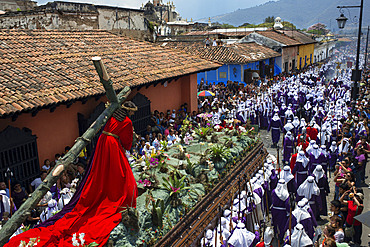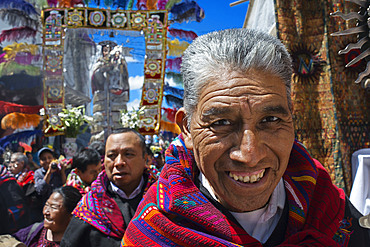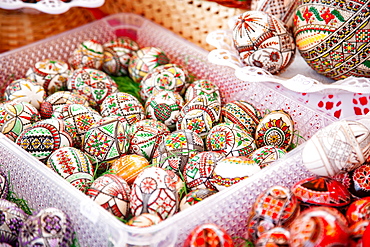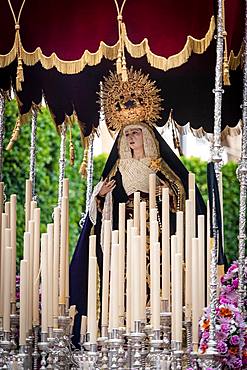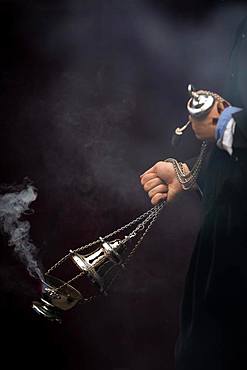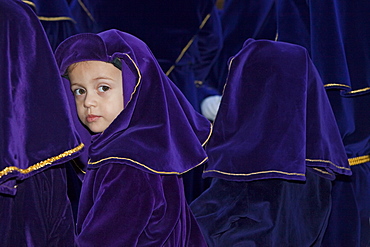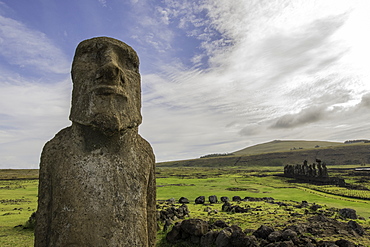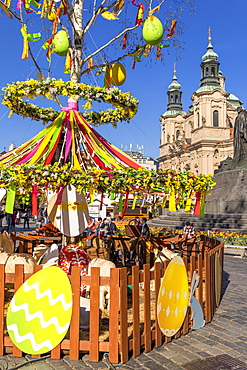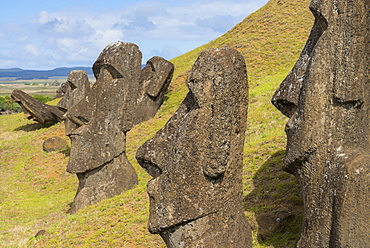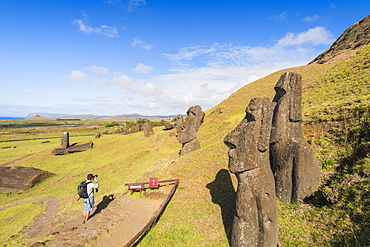Recent searches
Loading...
1350-3753 - Holy Week processions in Guatemala city. Holy Thursday. Comparsa. Holy Week in Guatemala is celebrated with street expressions of faith, called processions, usually organized by a "hermandades". Each procession of Holy Week has processional floats and steps, which are often religious images of the Passion of Christ, or Marian images, although there are exceptions, like the allegorical steps of saints.
1350-2691 - Verges, a small town in the Northeast of Catalonia (Spain), during Easter celebrates the Procession of Verges with skeletons dancing on the sound of a drum, Roman soldiers, known as the 'Manages', and a representation of the life and crucifixion of Jesus Christ. The Procession features the Dance of Death, a tradition from the Middle Age associated with epidemics and plagues and the only one remaining in Spain Ten skeletons dance to the beat of a drum to remember that no one is exempt of death. The backdrop of the medieval walls and towers of Verges is key to this macabre staging.
1350-2687 - Verges, a small town in the Northeast of Catalonia (Spain), during Easter celebrates the Procession of Verges with skeletons dancing on the sound of a drum, Roman soldiers, known as the 'Manages', and a representation of the life and crucifixion of Jesus Christ. The Procession features the Dance of Death, a tradition from the Middle Age associated with epidemics and plagues and the only one remaining in Spain Ten skeletons dance to the beat of a drum to remember that no one is exempt of death. The backdrop of the medieval walls and towers of Verges is key to this macabre staging.
1350-3763 - Easter Holy Week procession in Antigua, Guatemala. Jesus Nazareno de la Penitencia Procession in Antigua, Guatemala. Holy Week, friday.
1350-2689 - Verges, a small town in the Northeast of Catalonia (Spain), during Easter celebrates the Procession of Verges with skeletons dancing on the sound of a drum, Roman soldiers, known as the 'Manages', and a representation of the life and crucifixion of Jesus Christ. The Procession features the Dance of Death, a tradition from the Middle Age associated with epidemics and plagues and the only one remaining in Spain Ten skeletons dance to the beat of a drum to remember that no one is exempt of death. The backdrop of the medieval walls and towers of Verges is key to this macabre staging.
1350-2696 - Verges, a small town in the Northeast of Catalonia (Spain), during Easter celebrates the Procession of Verges with skeletons dancing on the sound of a drum, Roman soldiers, known as the 'Manages', and a representation of the life and crucifixion of Jesus Christ. The Procession features the Dance of Death, a tradition from the Middle Age associated with epidemics and plagues and the only one remaining in Spain Ten skeletons dance to the beat of a drum to remember that no one is exempt of death. The backdrop of the medieval walls and towers of Verges is key to this macabre staging.
1350-2697 - Verges, a small town in the Northeast of Catalonia (Spain), during Easter celebrates the Procession of Verges with skeletons dancing on the sound of a drum, Roman soldiers, known as the 'Manages', and a representation of the life and crucifixion of Jesus Christ. The Procession features the Dance of Death, a tradition from the Middle Age associated with epidemics and plagues and the only one remaining in Spain Ten skeletons dance to the beat of a drum to remember that no one is exempt of death. The backdrop of the medieval walls and towers of Verges is key to this macabre staging.
1350-2694 - Verges, a small town in the Northeast of Catalonia (Spain), during Easter celebrates the Procession of Verges with skeletons dancing on the sound of a drum, Roman soldiers, known as the 'Manages', and a representation of the life and crucifixion of Jesus Christ. The Procession features the Dance of Death, a tradition from the Middle Age associated with epidemics and plagues and the only one remaining in Spain Ten skeletons dance to the beat of a drum to remember that no one is exempt of death. The backdrop of the medieval walls and towers of Verges is key to this macabre staging.
1350-3775 - Chichicastenango, Quiche, Guatemala, Central America. Processions of Festival of Santo Thomas. On Easter Sunday The Comrades (Council Men) Carry The Andas (Floats) Of The Saints In Procession From The Santo Tomas
1178-34788 - Caucasian baby girl wearing Easter Bunny costume
1178-34789 - Caucasian baby girl wearing Easter Bunny costume
1113-105357 - Aborigine painting the face of an Asian girl, Face paints, Royal Easter Show, Sydney, NSW, Australia
1350-153 - The rising of the Full Moon on Easter eve, Saturday, March 31, 2018, on a very cold night with lots of snow still on the ground in Alberta. So this is more a winter Moon than a spring one. This is the 'paschal' Moon ' the one that defines the date of Easter, being the first Full Moon after the vernal equinox. The first Sunday after that Full Moon, in this case the next day, is Easter Sunday.
860-289249 - Coloring quail eggs with natural dyes for Easter, spring
860-289251 - Coloring quail eggs with natural dyes for Easter, spring
860-289252 - Coloring quail eggs with natural dyes for Easter, spring
860-289250 - Coloring quail eggs with natural dyes for Easter, spring
860-289253 - Coloring quail eggs with natural dyes for Easter, spring
1116-50427 - Close-up image showing the head of a standing moai against a blue sky; Easter Island, Chile
1116-50428 - A single moai on a blue background of sky, clouds and ocean; Easter Island, Chile
1116-50430 - A single moai at night against a starry sky; Easter Island, Chile
1116-50429 - The fifteen moais of Tongariki silhouetted against the brightly coloured sky of sunrise; Easter Island, Chile
832-390683 - Coloured quail eggs in small bowls, Easter eggs, Germany, Europe
832-390684 - Coloured quail eggs in shell, Easter eggs, Germany, Europe
1265-191 - Traditional painted Easter eggs, Transylvania, Romania, Europe
1178-30907 - Tree twigs forming cross on old open bible
832-389923 - European hare (Lepus europaeus) pricks its ears, Easter hare, mammal, Oldenburg Muensterland, Germany, Europe
1113-103937 - Illuminated statue in the evening, Moai Ko Te Rilku, Tahai, Easter Island, Chile, South America, America
832-385196 - Paso de la Virgen, statue of the Virgin Mary with canopy, Semana Santa procession, Holy Week, Almeria, Andalusia, Spain, Europe
832-385195 - Silver incense barrel with steaming incense is swivelled, Semana Santa, Holy Week, Almeria, Andalusia, Spain, Europe
794-1168 - Semana Santa (Holy Week) celebrations, Malaga, Andalucia, Spain, Europe
1116-47463 - Display of confectioneries behind glass at a bakery, Italy
1116-47457 - Baked goods on display in an Italian bakery, Italy
1218-1229 - Locals of Chinceros celebrating Easter, Chincheros, Peru, South America
1320-13 - Easter Island heads, Easter Island (Rapa Nui), UNESCO World Heritage Site, Chile, South America
1320-11 - Easter Island heads, Easter Island (Rapa Nui), UNESCO World Heritage Site, Chile, South America
1320-12 - Easter Island heads, Easter Island (Rapa Nui), UNESCO World Heritage Site, Chile, South America
809-7892 - Pope Francis presides over Easter Holy Mass in St. Peter's Square at the Vatican, Rome, Lazio, Italy, Europe
1178-27510 - Baby girl with Easter egg and basket in back yard
1178-27511 - Baby girl with Easter egg and basket in back yard
1283-897 - Historical buildings seen from the Easter market at the old town market square at dusk, Prague, Bohemia, Czech Republic, Europe
1283-891 - Facades of historical buildings seen from the Easter market at the old town market square, Prague, Bohemia, Czech Republic, Europe
1283-882 - Easter Market at the old town market square, UNESCO World Heritage Site, Prague, Bohemia, Czech Republic, Europe
1283-879 - Easter Market at the old town market square with St. Nicholas Church in the background, Prague, Bohemia, Czech Republic, Europe
1283-844 - St. Nicholas' Church seen from the Easter Market at the old town market square, UNESCO World Heritage Site, Prague, Bohemia, Czech Republic, Europe
1283-833 - Tower of the old town hall seen from the Easter Market at the old town market square, UNESCO World Heritage Site, Prague, Bohemia, Czech Republic, Europe
1186-619 - Moai heads of Easter Island, Rapa Nui National Park, UNESCO World Heritage Site, Easter Island, Chile, South America
1186-611 - Moai heads of Easter Island, Rapa Nui National Park, UNESCO World Heritage Site, Easter Island, Chile, South America
1186-626 - Moai heads of Easter Island, Rapa Nui National Park, UNESCO World Heritage Site, Easter Island, Chile, South America
1186-615 - Moai heads of Easter Island, Rapa Nui National Park, UNESCO World Heritage Site, Easter Island, Chile, South America
1186-622 - Moai heads of Easter Island, Rapa Nui National Park, UNESCO World Heritage Site, Easter Island, Chile, South America
1186-610 - Moai heads of Easter Island, Rapa Nui National Park, UNESCO World Heritage Site, Easter Island, Chile, South America
1186-616 - Moai heads of Easter Island, Rapa Nui National Park, UNESCO World Heritage Site, Easter Island, Chile, South America
1186-621 - Moai heads of Easter Island, Rapa Nui National Park, UNESCO World Heritage Site, Easter Island, Chile, South America
1186-614 - Moai heads of Easter Island, Rapa Nui National Park, UNESCO World Heritage Site, Easter Island, Chile, South America
1186-618 - Moai heads of Easter Island, Rapa Nui National Park, UNESCO World Heritage Site, Easter Island, Chile, South America
1186-617 - Moai heads of Easter Island, Rapa Nui National Park, UNESCO World Heritage Site, Easter Island, Chile, South America
1186-612 - Moai heads of Easter Island, Rapa Nui National Park, UNESCO World Heritage Site, Easter Island, Chile, South America
1186-625 - Moai heads of Easter Island, Rapa Nui National Park, UNESCO World Heritage Site, Easter Island, Chile, South America
1186-613 - Moai heads of Easter Island, Rapa Nui National Park, UNESCO World Heritage Site, Easter Island, Chile, South America
1186-620 - Moai heads of Easter Island, Rapa Nui National Park, UNESCO World Heritage Site, Easter Island, Chile, South America
1186-624 - Moai heads of Easter Island, Rapa Nui National Park, UNESCO World Heritage Site, Easter Island, Chile, South America
1186-623 - Moai heads of Easter Island, Rapa Nui National Park, UNESCO World Heritage Site, Easter Island, Chile, South America
1186-608 - Moai heads of Easter Island, Rapa Nui National Park, UNESCO World Heritage Site, Easter Island, Chile, South America
1186-600 - Moai heads of Easter Island, Rapa Nui National Park, UNESCO World Heritage Site, Easter Island, Chile, South America
1186-589 - Moai heads of Easter Island, Rapa Nui National Park, UNESCO World Heritage Site, Easter Island, Chile, South America
1186-591 - Moai heads of Easter Island, Rapa Nui National Park, UNESCO World Heritage Site, Easter Island, Chile, South America
1186-592 - Moai heads of Easter Island, Rapa Nui National Park, UNESCO World Heritage Site, Easter Island, Chile, South America
1186-602 - Moai heads of Easter Island, Rapa Nui National Park, UNESCO World Heritage Site, Easter Island, Chile, South America
1186-605 - Moai heads of Easter Island, Rapa Nui National Park, UNESCO World Heritage Site, Easter Island, Chile, Polynesia, South America
1186-584 - Moai heads of Easter island, Rapa Nui National Park, UNESCO World Heritage Site, Easter Island, Chile, South America
1186-593 - Moai heads of Easter Island, Rapa Nui National Park, UNESCO World Heritage Site, Easter Island, Chile, South America
1186-595 - Moai heads of Easter Island, Rapa Nui National Park, UNESCO World Heritage Site, Easter Island, Chile, South America
1186-585 - Moai heads of Easter Island, Rapa Nui National Park, UNESCO World Heritage Site, Easter Island, Chile, South America
1186-588 - Moai heads of Easter Island, Rapa Nui National Park, UNESCO World Heritage Site, Easter Island, Chile, South America
1186-601 - Moai heads of Easter Island, Rapa Nui National Park, UNESCO World Heritage Site, Easter Island, Chile, South America
1186-599 - Moai heads of Easter Island, Rapa Nui National Park, UNESCO World Heritage Site, Easter Island, Chile, South America
1186-596 - Moai heads of Easter Island, Rapa Nui National Park, UNESCO World Heritage Site, Easter Island, Chile, South America
1186-609 - Moai heads of Easter Island, Rapa Nui National Park, UNESCO World Heritage Site, Easter Island, Chile, South America
1186-590 - Moai heads of Easter Island, Rapa Nui National Park, UNESCO World Heritage Site, Easter Island, Chile, South America
1186-597 - Moai heads of Easter Island, Rapa Nui National Park, UNESCO World Heritage Site, Easter Island, Chile, South America
1186-594 - Moai heads of Easter Island, Rapa Nui National Park, UNESCO World Heritage Site, Easter Island, Chile, South America
1186-607 - Moai heads of Easter Island, Rapa Nui National Park, UNESCO World Heritage Site, Easter Island, Chile, South America
1186-604 - Moai heads of Easter Island, Rapa Nui National Park, UNESCO World Heritage Site, Easter Island, Chile, South America
1186-598 - Moai heads of Easter Island, Rapa Nui National Park, UNESCO World Heritage Site, Easter Island, Chile, South America
1186-606 - Moai heads of Easter Island, Rapa Nui National Park, UNESCO World Heritage Site, Easter Island, Chile, South America
1186-583 - Moai heads of Easter Island, Rapa Nui National Park, UNESCO World Heritage Site, Easter Island, Chile, South America
1186-586 - Moai heads of Easter Island, Rapa Nui National Park, UNESCO World Heritage Site, Easter Island, Chile, South America
1186-603 - Moai heads of Easter Island, Rapa Nui National Park, UNESCO World Heritage Site, Easter Island, Chile, South America
1186-587 - Moai heads of Easter Island, Rapa Nui National Park, UNESCO World Heritage Site, Easter Island, Chile, South America
1186-582 - Moai heads of Easter Island, Rapa Nui National Park, UNESCO World Heritage Site, Easter Island, Chile, South America
1186-580 - Moai heads of Easter Island, Rapa Nui National Park, UNESCO World Heritage Site, Easter Island, Chile, South America
1186-581 - Moai heads of Easter Island, Rapa Nui National Park, UNESCO World Heritage Site, Easter Island, Chile, South America
809-7663 - Ethiopian Orthodox Christians celebrating Easter, vigil outside the Church of the Holy Sepulchre, Jerusalem, Israel, Middle East
809-7664 - Ethiopian Orthodox Christians celebrating Easter, vigil outside the Church of the Holy Sepulchre, Jerusalem, Israel, Middle East
809-7665 - Ethiopian Orthodox Christians celebrating Easter, vigil outside the Church of the Holy Sepulchre, Jerusalem, Israel, Middle East
809-7658 - Ethiopian Orthodox Christians celebrating Easter vigil outside the Church of the Holy Sepulchre, Jerusalem, Israel, Middle East



